Another week with tons of first issues — there are eleven reviewed here, and that wasn’t even all of them — but first let’s start with a book that’s more a last issue than a first:
 Life With Archie #36 — Writer: Paul Kupperberg; Pencils: Pat and Tim Kennedy; Inks: Jim Amash
Life With Archie #36 — Writer: Paul Kupperberg; Pencils: Pat and Tim Kennedy; Inks: Jim Amash
This is the comic where Archie “dies.” Now, as readers of this website, you’ll no doubt find it easier than civilians to grasp that Life With Archie is set in the future, and has been exploring what happens to the Riverdale gang after high school (in one timeline, Archie married Veronica; on another, he married Betty, and so on), so his death here doesn’t stop the “real” comics from still chronicling his other, eternally-high-school-set adventures. The plot involves a grown-up Kevin Keller (the Archie company’s first “out” gay character) running for senator, on a platform advocating gun control, and he’s come back to his home town to campaign — but his views have made him an assassination target, and, well… the comic’s cover pretty much tells you what happens next. Between Keller’s sexual orientation and the gun-control thing, this is the kind of story that will cause regular Fox News viewers’ heads to explode — but one of the attractions of Riverdale is that it’s always been a tolerant place, and Archie’s its pure, smalltown heart, so it all works well in context; the story itself is satisfying and well-drawn (with a nice combination of cartoony and realistic), and gives Ol’ Carrot-Top a suitably heroic sendoff.
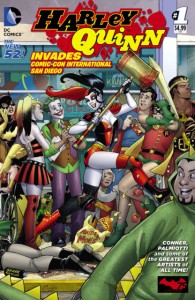 Harley Quinn Invades Comic-Con International San Diego #1 (of 1) — Writers: Amanda Connor and Jimmy Palmiotti; Artists: Paul Pope, Javier Garron, Damion Scott and Robert Campanella, Amanda Connor, John Timms, Marco Failla, Dave Johnson, and Stephanie Roux
Harley Quinn Invades Comic-Con International San Diego #1 (of 1) — Writers: Amanda Connor and Jimmy Palmiotti; Artists: Paul Pope, Javier Garron, Damion Scott and Robert Campanella, Amanda Connor, John Timms, Marco Failla, Dave Johnson, and Stephanie Roux
This is just what you think: a jam issue with tons of in-jokes, involving Harley going to San Diego. Don’t get too excited by the credits: that’s a number of good artists, but Pope, for example, only does one page, while Connor does a three-page sequence showing Harley’s own attempts at drawing a comic (part of the plot has her getting her art portfolio reviewed by Jim Lee). Still, watching our heroine meet Paul Dini and Bruce Timm, or try to buy a copy of Batman Adventures #12 from a particularly mercenary con dealer, is more than enough to make it worth the $4.99 cover price.
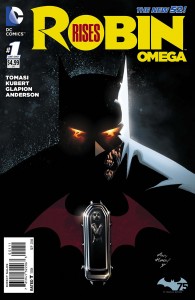 Robin Rises: Omega #1 (of 1) — Writer: Peter Tomasi; Pencils: Andy Kubert; Inks: Jonathan Glapion
Robin Rises: Omega #1 (of 1) — Writer: Peter Tomasi; Pencils: Andy Kubert; Inks: Jonathan Glapion
The “Robin” referenced here is Damian Wayne, who’s currently still dead (I assume that’s why the book’s title uses “omega” instead of “alpha,” even though it’s the leadoff to the story, with subsequent episodes boomeranging (bataranging?) among the various bat-comics), although when you’re a corporate comic-book character “death” is a slippery term (just ask Archie Andrews…). Anyway, agents of Apokolips steal the kid’s casket, because it has some kind of “chaos shard” maguffin embedded in it, and Batman and Ra’s Al Ghul and the JLA try to stop them, and, obviously, things don’t go well, because then what would all those crossover comics have to talk about? It’s fine for what it is; Kubert’s art is the strongest point (particularly the seven-page sequence at the beginning that attempts to summarize Batman’s long, involved history with Ra’s, Talia and Damian), and I’m assuming that we’ll see him again in a couple of months for Robin Rises: Alpha, and the resolution/resurrection of the character.
 Teen Titans #1 — Writer: Will Pfeifer; Art: Kenneth Rocafort
Teen Titans #1 — Writer: Will Pfeifer; Art: Kenneth Rocafort
Yet another relaunch for this group, with the current incarnation featuring Wonder Girl, Red Robin, Beast Boy, Raven and Bunker. Unlike too many first issues, it does a decent, clear job of introducing everyone and their powers, as they’re dealing with a terrorist/schoolbus hostage crisis in midtown Manhattan (although it felt a little off to have Bunker shoehorn an “I’m gay and proud” speech in, too: it’s not a power, guys, and not something you have to establish within the first ten panels; you could have left that information for a later issue), and gets points for not ending on a cheap cliffhanger: it offers a full story, so readers don’t feel shorted, but with enough dangling subplots to bring them back for the next installment. Overall, it’s a solid, professional job, and one fans of the previous versions of the title should appreciate.
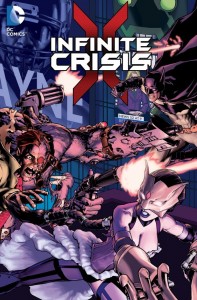 Infinite Crisis: Fight for the Multiverse #1 — Writer: Dan Abnett; Layouts: Carl Potts; Pencils: Larry Stroman; Inks: Trevor Scott
Infinite Crisis: Fight for the Multiverse #1 — Writer: Dan Abnett; Layouts: Carl Potts; Pencils: Larry Stroman; Inks: Trevor Scott
This is based on the Infinite Crisis videogame/multiplayer online battle arena, so it has little to do with the original IC comic, except that there’s, you know, a crisis, and so different versions of the iconic DC characters from the 52 parallel Earths have to get together to resolve it: “our” Batman, plus Elseworlds-like versions of Wonder Woman, Green Lantern and Robin, at least to start. It’s not strictly in continuity, and probably seems cooler if you’ve never heard the word “Elseworlds” before, or if you actually play the game itself, but it’s nice to see Stroman doing some work again — and, hey, I’ve been spending the summer getting to level 280 of Candy Crush, so I’m not the one to criticize other people’s online gaming choices….
 The Squidder #1 (of 4) — Writer/Artist: Ben Templesmith
The Squidder #1 (of 4) — Writer/Artist: Ben Templesmith
Now we’re getting into the smaller-publisher first issues: this one goes first because Templesmith has such an independent, original style; you either like his shadowy, impressionistic horror approach, or you don’t. I like it fine, and this post-apocalyptic-wasteland tale about an Earth conquered by floating squid space aliens (the title character was one of the humans biologically modified to fight them, and one of the few to survive) is just the kind of Mad Max/H. P. Lovecraft mashup that plays to his strengths.
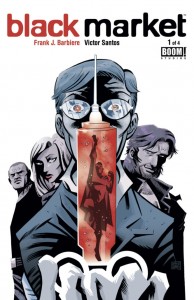 Black Market #1 (of 4) — Writer: Frank Barbiere; Art: Victor Santos
Black Market #1 (of 4) — Writer: Frank Barbiere; Art: Victor Santos
This mini-series is set on one of those generic super-hero Earths, and is about a chemist whose bad-seed brother gets him mixed up in a scheme to use the DNA from super-powered people’s blood to make money and (he thinks) do good deeds. Although it’s an idea that’s been used before (Mark Waid’s Empire went down a similar road, for example, and Uncanny X-Men just did it with Dazzler, too), it’s fairly well done, with a good choice of a sympathetic protagonist, and there’s enough going on to justify readers coming back for a second issue, at least.
 Dark Engine #1 — Writer: Ryan Burton; Art: John Bivens
Dark Engine #1 — Writer: Ryan Burton; Art: John Bivens
This one’s about a woman assassin, apparently with semi-occult origins, who’s been created to go back in time and assassinate the creator of yet another of those post-apocalyptic wastelands in his crib, and thus prevent that future from occurring. However, the time device misfires, sending her back to prehistoric times instead; since she’s trained to pretty much kill everything she meets, she survives, and then it starts hopscotching her forward… it reminds me a little of Pretty Deadly, although neither the script nor the art are at the level of that book; the writing tends a little too much to purple prose (“At the eastern edge of that poison absolute, a creamy nimbus pierces the hopelessness…”), and the visuals could sometimes use more clarity in their layout and flow. It’s got creative passion going for it, though, and the raw energy that provides; if this team can sand off some of the rough edges, it could develop into something special.
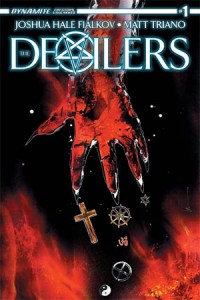 The Devilers #1 (of 7) — Writer: Joshua Hale Fialkov; Art: Matt Triano
The Devilers #1 (of 7) — Writer: Joshua Hale Fialkov; Art: Matt Triano
Fialkov’s all over the place right now; his The Life After, about a guy who gradually realizes he’s in Purgatory (and then meets Ernest Hemingway) came out last week, and now there’s this. It’s more standard fare than Life After, about a group of exorcists — a reluctant priest, a female Mossad agent, an Indian fakir, a demonologist (complete with pet demon), and so on — battling an invasion from Hell. We’ve already cycled through vampires and zombies; now, with Robert Kirkman’s new Outcast and this, we’re apparently going to get a flood of exorcism stories next. It’s fine, if you like that sort of thing, but I prefer Life After‘s quirky, more humorous approach to the dark, grim goings-on here.
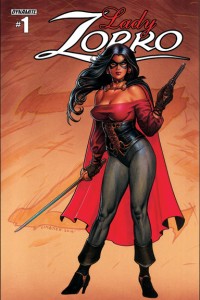 Lady Zorro #1 (of 4) — Writer: Alex de Campi; Art: Rey Villegas
Lady Zorro #1 (of 4) — Writer: Alex de Campi; Art: Rey Villegas
This is the character last seen in Matt Wagner’s Zorro Rides Again; in that story, she was impersonating Don Diego’s swashbuckling alter ego, but now he’s asking for her help: he’s going out of the country, and needs her to don the “Z” costume and re-steal a sacred Indian relic in his absence. Naturally, she has to go through an empire-building condesa and her sadistic German general husband to do it, and complications ensue. Fans of the Old California setting and the “Zorro” franchise should like this, and the Joseph Michael Linsner cover might attract a few new ones, too; like many books this week, it doesn’t break any new ground, but does a competent job telling a familiar story.
 The Last Fall #1 (of 5) — Writer: Tom Waltz; Art: Casey Maloney
The Last Fall #1 (of 5) — Writer: Tom Waltz; Art: Casey Maloney
This is a science-fiction book about a solar system with two planets: one’s a desert world with abundant energy resources; the other, more technologically-advanced, has colonized and exploited it in the past. Now, their sun’s becoming a red giant, and they need to mine the desert-planet energy to escape it, but the once-compliant natives resent the invasion and declare war. The set-up has obvious parallels to current events (the US, Iraq/Afghanistan, and the oil reserves there, especially since the main character is a soldier from the higher-tech planet fighting on the desert one); that gives it some oomph, as does the realism in some of the battle scenes and the intra-unit squabbling by the soldiers. On the other hand, there are some rookie mistakes: for example, all of the backstory is told to readers in tiny, white-on-black print on the first page, making it almost impossible to read; also, the characters don’t really resonate yet, and all the world-building background tends to be more interesting than the actual story. I’m mildly interested in where this is going, but so far there’s more potential than actual quality here.
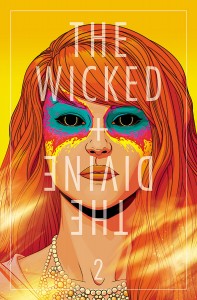 The Wicked and the Divine #2 — Writer: Kieron Gillen; Art: Jamie McKelvie
The Wicked and the Divine #2 — Writer: Kieron Gillen; Art: Jamie McKelvie
With all those first issues out of the way, we’re now getting into the repeat stuff — The Wicked and the Divine is the best, and the one I’ve talked about the least, since it’s only on its second issue. Gillen and McKelvie are a powerful team (their Young Avengers and Phonogram: The Singles Club are both available as trades, and well worth seeking out), and this story about young people tapped to be the avatars of a pantheon of 12 gods (they get power and fame, but the catch is, after two years they die) has a lot to say about pop culture, art and death, wrapped around McKelvie’s attractive and intriguing art. The first issue sold out quickly, but there’s a second printing available now, so it’s easy to read the first two installments at once, and see what the fuss is about.
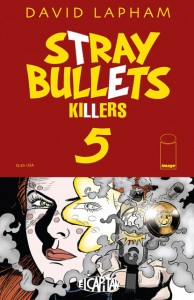 Stray Bullets: Killers #5 — Writer/Artist: David Lapham
Stray Bullets: Killers #5 — Writer/Artist: David Lapham
This issue involves the Amy Racecar character, probably the most popular of Lapham’s original run on this series — and the strangest, since her adventures don’t seem “real” within the context of the rest of the book; they’re like some other character’s weird daydreams, or not-quite-clear fables with sad, unresolved endings (this one involves an offbeat Cinderella story, except that Cinderella is a boy with no arms or legs, and there are evil moms and rocket ships and TV episodes and lots of people die and… well, as I said: strange — but 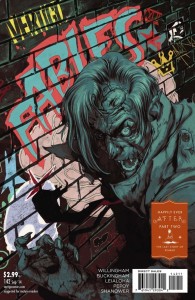 never boring, even if they don’t count in the careful, piece-of-the-puzzle way all the other stories do).
never boring, even if they don’t count in the careful, piece-of-the-puzzle way all the other stories do).
Fables #142 — Writer: Bill Willingham; Pencils: Mark Buckingham; Inks: Steve Leialoha and Andrew Pepoy
Silver Surfer #4 — Writer: Dan Slott; Art: Michael Allred
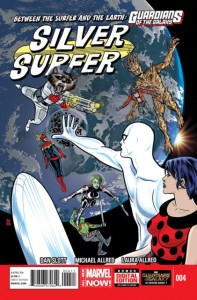 She-Hulk #6 — Writer: Charles Soule; Art: Ron Wimberly
She-Hulk #6 — Writer: Charles Soule; Art: Ron Wimberly
Uncanny X-Men #23 — Writer: Brian Michael Bendis; Art: Kris Anka
Secret Avengers #5 — Writer: Ales Kot; Art: Michael Walsh
 These are all books I’ve reviewed in previous posts, so I’ll just cover each one quickly here; check the archives if you want more details. Fables is moving toward its end early next year, and is concentrating on an involved Camelot-like endgame, and the fate of the Bigby character. Silver Surfer is a lot of fun, a light offbeat love story with sidebars for the Guardians of the Galaxy, the Defenders and seafood bisque. It’s got Michael Allred art, so just shut up and buy it (I’ve been
These are all books I’ve reviewed in previous posts, so I’ll just cover each one quickly here; check the archives if you want more details. Fables is moving toward its end early next year, and is concentrating on an involved Camelot-like endgame, and the fate of the Bigby character. Silver Surfer is a lot of fun, a light offbeat love story with sidebars for the Guardians of the Galaxy, the Defenders and seafood bisque. It’s got Michael Allred art, so just shut up and buy it (I’ve been 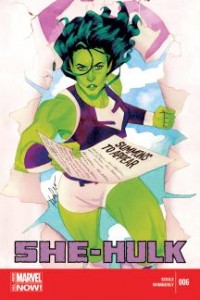 restocking X-Force books this week, and that title eventually morphed into Allred and writer Peter Milligan’s groundbreaking, sharply funny X-Statix, an early-oughts Nu-Marvel highlight: check those out, too). She-Hulk has a bright script by Soule; Walsh’s experimental layouts and impressionistic art make it pop, although I’m not always sure about the art (there’s one scene where the character becomes much more Hulk-like while fighting, and I can’t tell whether that’s a plot point or just inconsistent
restocking X-Force books this week, and that title eventually morphed into Allred and writer Peter Milligan’s groundbreaking, sharply funny X-Statix, an early-oughts Nu-Marvel highlight: check those out, too). She-Hulk has a bright script by Soule; Walsh’s experimental layouts and impressionistic art make it pop, although I’m not always sure about the art (there’s one scene where the character becomes much more Hulk-like while fighting, and I can’t tell whether that’s a plot point or just inconsistent 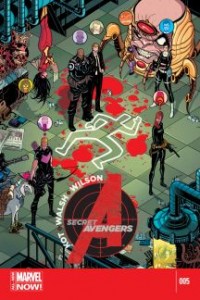 illustration). Uncanny X-Men is the briskly-entertaining book it always is, although I miss Chris Bachalo’s versions of the characters, and that last will and testament highlighted on the cover is still unread by the end of the issue. Finally, Secret Avengers has assembled a nicely-comic little repertoire company of characters, including Agent Coulson, Maria Hill, Hawkeye, the Black Widow and, of all beings, M.O.D.O.K., and is in the middle of telling a surprisingly-affecting story about them; it’s just the right comic to end the week with.
illustration). Uncanny X-Men is the briskly-entertaining book it always is, although I miss Chris Bachalo’s versions of the characters, and that last will and testament highlighted on the cover is still unread by the end of the issue. Finally, Secret Avengers has assembled a nicely-comic little repertoire company of characters, including Agent Coulson, Maria Hill, Hawkeye, the Black Widow and, of all beings, M.O.D.O.K., and is in the middle of telling a surprisingly-affecting story about them; it’s just the right comic to end the week with.



